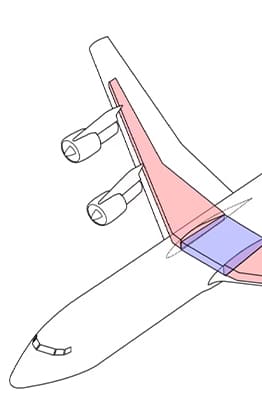Placing the fuel tanks in the wings takes advantage of valuable space while improving stability and economics.

There are several reasons why many modern aircraft designers have elected to place the primary fuel tanks in the wings. An aircraft’s wing contains a significant amount of extra space not used for storage, is easily accessible, and is responsible for creating lift for the entire airframe.
Placing the fuel in the wings also increases the strength and stability of the aircraft during takeoff and leaves room for additional cargo capacity.
Storage, and the lift factor
When considering the aerodynamics of an aircraft, the wings are directly responsible for creating the lift, which supports the fuselage containing cargo and passengers during flight. On some long-haul flights, the fuel contained in the aircraft at takeoff can account for as much as a third of the aircraft’s gross weight.
The Boeing 747 notably burns up to one gallon of fuel per second of flight and must carry enough accordingly. Even next-generation jets must maintain significant fuel to cover the actual trip alongside reserves for taxiing, diverting, contingencies, and other emergencies. Today’s twin-engine aircraft, such as the Airbus A350, are able to carry over 37,000 gallons of fuel.

Photo: Tosaka via Wikimedia Commons
The wings also contain controls for the ailerons and flaps, alongside various flight electronic and hydraulic equipment. Luggage and other cargo, however, are not typically stored in the wing due to height restrictions but are instead stored in the fuselage.
Strength, understanding the flex and flutter
The fuel tanks in the wings, especially when full, provide strength and stability to the aircraft during takeoff. The full tanks increase the rigidity of the wings and spread the total takeoff weight more evenly across the aircraft. As the aircraft speeds down the runway, the extra weight helps to keep the wingtips down and level to balance the disproportionally heavy fuselage.
Some aircraft’s wings are designed to flex to improve aerodynamic stability. This development is most notable in jetliners such as the Boeing 787 Dreamliner, which incorporates composite technology to allow the wings to flex up to 25 feet. The result is a more streamlined aircraft with reduced drag and the ability to adapt more dynamically to turbulence.
Baffles further subdivide the fuel tanks. The rigid partitions within the tanks are placed perpendicular to the wings and feature small holes to prevent the fuel from sloshing side to side during the flight. Some aircraft also include systems to rebalance the tanks manually should one side become heavier than the other.
Systems, where else could it be?
Aircraft fuel has not always been stored in the wings, and while it is the most common location in today’s commercial jetliners, there are still several outliers. Several aircraft in the Airbus A320 family also have the ability to load fuel tanks in the cargo hold. The Airbus A321LR, for instance, can hold up to three removable fuel tanks for long-range trips. The A321XLR features an integrated central fuel tank to increase its range.
One benefit of storing fuel in the wings is the ability to gravity feed. As the fuel tanks are above the engines in many aircraft, this can help reduce reliance on a fuel pump. Aircraft which feature a center fuel tank in the belly of the plane to hold reserve fuel usually empty it first to ensure that gravity feeding is available for as long as possible.
Some widebody aircraft include fuel tanks in the rear of the plane. The fuel in tanks set in the horizontal stabilizers doubles as ballast to manage the center of gravity on long-haul flights.

Future shifts
There may be some changes ahead, especially concerning the introduction of hydrogen aircraft. When it comes to Airbus’ ZEROe concepts, the European aircraft manufacturer’s turbofan and turboprops are being conceptualized to have their liquid hydrogen storage and distribution units behind the rear pressure bulkhead.
However, the innovative blended-wing-body BWB design features liquid hydrogen storage tanks stored underneath the wings. Thus, despite the transformations, there may still be some familiarities in this next chapter.
Source: Simple Flying

Warning: Illegal string offset 'cookies' in /home/u623323914/domains/eng.bayviet.com.vn/public_html/wp-includes/comment-template.php on line 2564